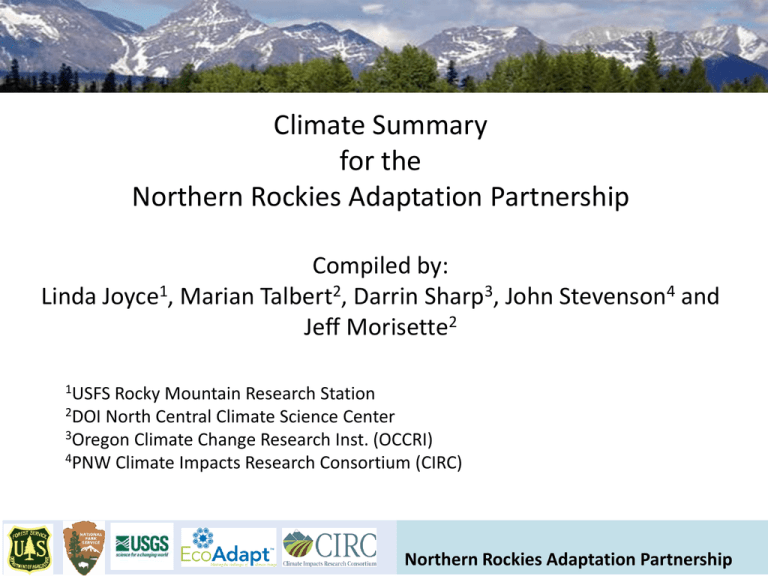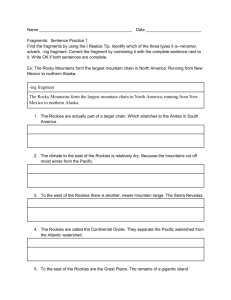Climate Summary for the Northern Rockies Adaptation Partnership
advertisement

Climate Summary for the Northern Rockies Adaptation Partnership Compiled by: Linda Joyce1, Marian Talbert2, Darrin Sharp3, John Stevenson4 and Jeff Morisette2 1USFS Rocky Mountain Research Station 2DOI North Central Climate Science Center 3Oregon Climate Change Research Inst. (OCCRI) 4PNW Climate Impacts Research Consortium (CIRC) Northern Rockies Adaptation Partnership outline - General overview of climate modeling - Historical and projected climate for the NRAP region - Sub-region specific climate information Northern Rockies Adaptation Partnership Historical data Long term (paleo-climate) Observations from weather stations Gridded observations Historical modeled Projections for future scenarios Global Climate Models Statistically Downscaled Global Climate Models Regional Climate Models Northern Rockies Adaptation Partnership Model physics Northern Rockies Adaptation Partnership Downscaling Image courtesy of John Stamm, USGS Northern Rockies Adaptation Partnership Modeled human (anthropogenic) forcings RCP = representative concentration pathways Energy sources by sector (van Vuuren et.al. 2011) Northern Rockies Adaptation Partnership The NRAP Climate Summary Chapter will use… Historical Climate Data come from: • Maurer et al. dataset (2002) • PRISM (2014) Modeled climate data come from: • CMIP5 - Coupled Model Inter-comparison Project Data • Representative Concentration Pathways (RCP): 4.5 and 8.5 • with Bias Correction and Spatial Disaggregation (BCSD) statistical downscaling algorithm (Wood et al., 2004) • Looking at “normal” (~30 year averages) for 1979-2009, 2030-2059, and 2070-2099. Northern Rockies Adaptation Partnership Variability across climate models Example for NRAP Central Region Northern Rockies Adaptation Partnership Northern Rockies Adaptation Partnership Northern Rockies Adaptation Partnership Northern Rockies Adaptation Partnership Northern Rockies Adaptation Partnership Northern Rockies Adaptation Partnership Central NRAP Subregion Historic and Projected Climate Climatologically, the region sits at the boundary between the warm, wet, maritime airflows from the Pacific Ocean, and the cooler, drier airflows from Canada. Northern Rockies Adaptation Partnership Historic trends indicate statistically significant warming, with a minimal increase in ppt. Tmax = 0.13 °F/decade, Tmin = 0.26 °F/decade. 4km PRISM data Projections call for continued warming, with emissions being a major uncertainty. Tmin/Tmax +5-11 °F by 2100, as compared to 1950-2012. CMIP5 model ensemble Projections call for continued warming, with emissions being a major uncertainty. Tmin/Tmax +5-11 °F by 2100, as compared to 1950-2012. CMIP5 model ensemble Projections for ppt are less certain; but it will probably be slightly wetter on an annual basis. CMIP5 model ensemble Seasonal Tmax. Warmer in all seasons. CMIP5 model ensemble Seasonal Tmin. Warmer in all seasons. CMIP5 model ensemble Seasonal Precipitation. Suggestion is for drier summers; wetter winters and springs; fall about the same. CMIP5 model ensemble Other subregions exhibit similar responses. Mean Monthly Tmax, Tmin, Ppt Tmax (°F) Tmin (°F) Ppt (in) Historic (18952012) +0.5-2 +2-3 Slight increase Future (at 2100) +5-11 +5-11 An increase of ~5-15% annually • Fall = ~same • Winter & Spring = a little wetter • Summer = a little drier Northern Rockies Adaptation Partnership Regional summary: Yellowstone: Climate variability is strongly influenced by the interactions with topography, elevation, and aspect. Grasslands: Pattern of dryer west and wetter east, with the average of climate models showing a slight shift for more of the wetter east and warming implies earlier snow melt. East, Central, and West: Warmer and slightly wetter. Northern Rockies Adaptation Partnership Some important terms & acronyms Intergovernmental Panel on Climate Change (IPCC) Assessment Reports (AR) FAR (first AR), second (SAR), third (TAR), AR4, AR5,… CMIP5 - Coupled Model Inter-comparison Project (CMIP5 = most current & goes with Assessment Report 5) GCM: Global Climate Models RCM: Regional Climate Models Representative Concentration Pathways (RCP) (which is the CMIP5 term for emissions scenarios, in CMIP3 they were referred to as SRES, special report on Emissions Scenarios) Downscaling: statistical or dynamical Northern Northern Rockies Rockies Adaptation Adaptation Partnership Partnership



